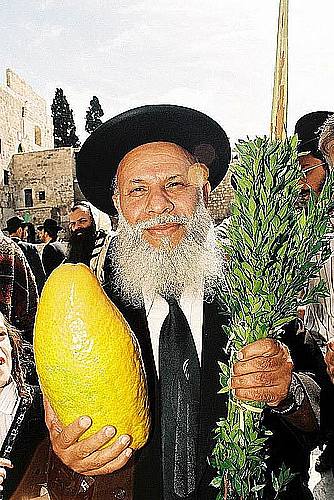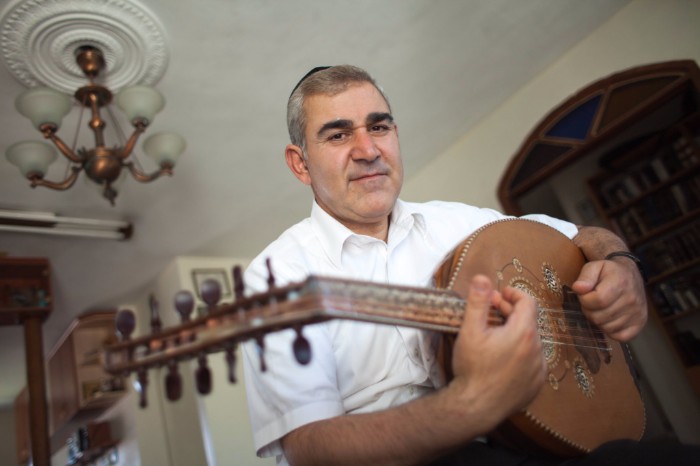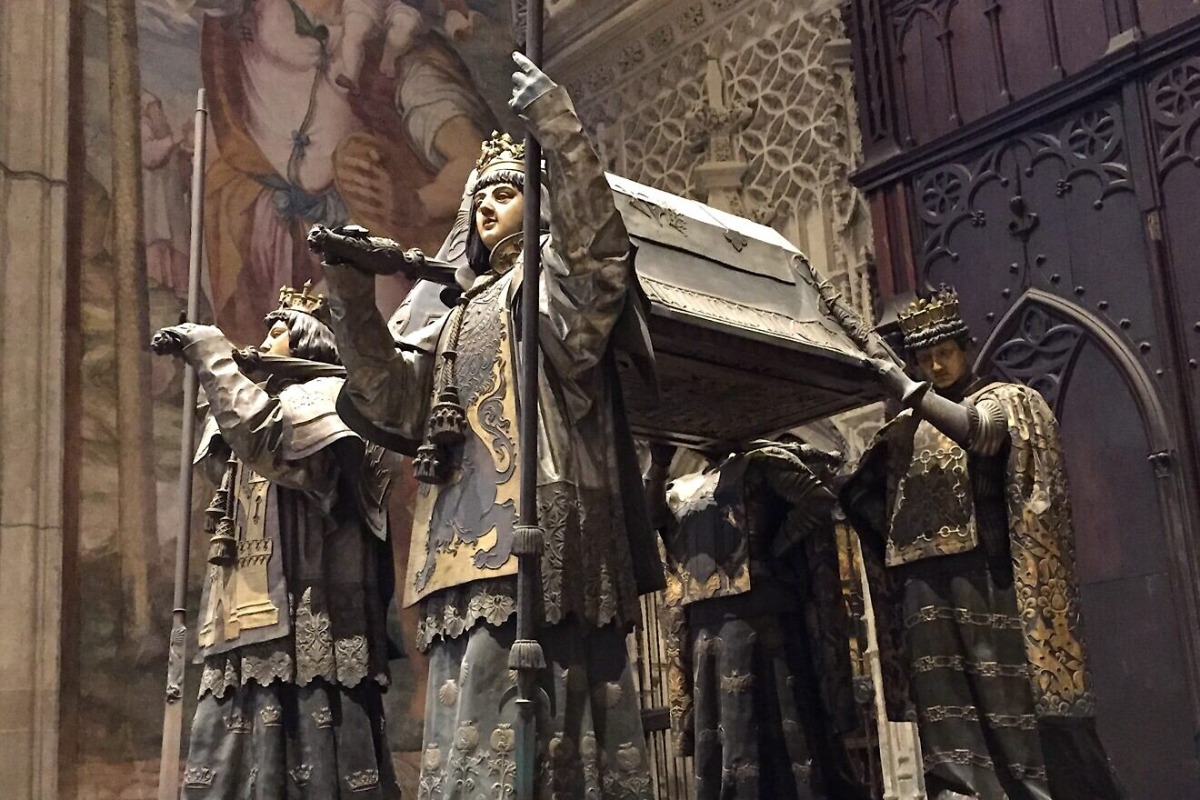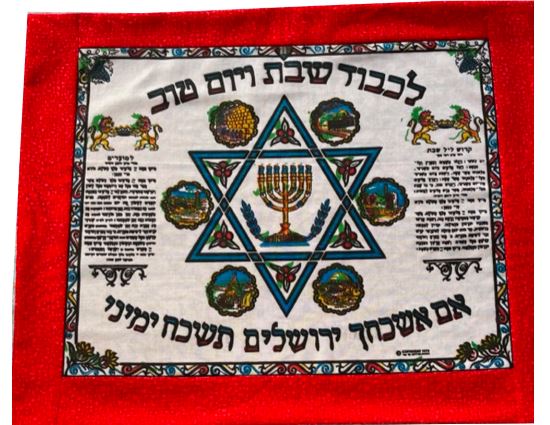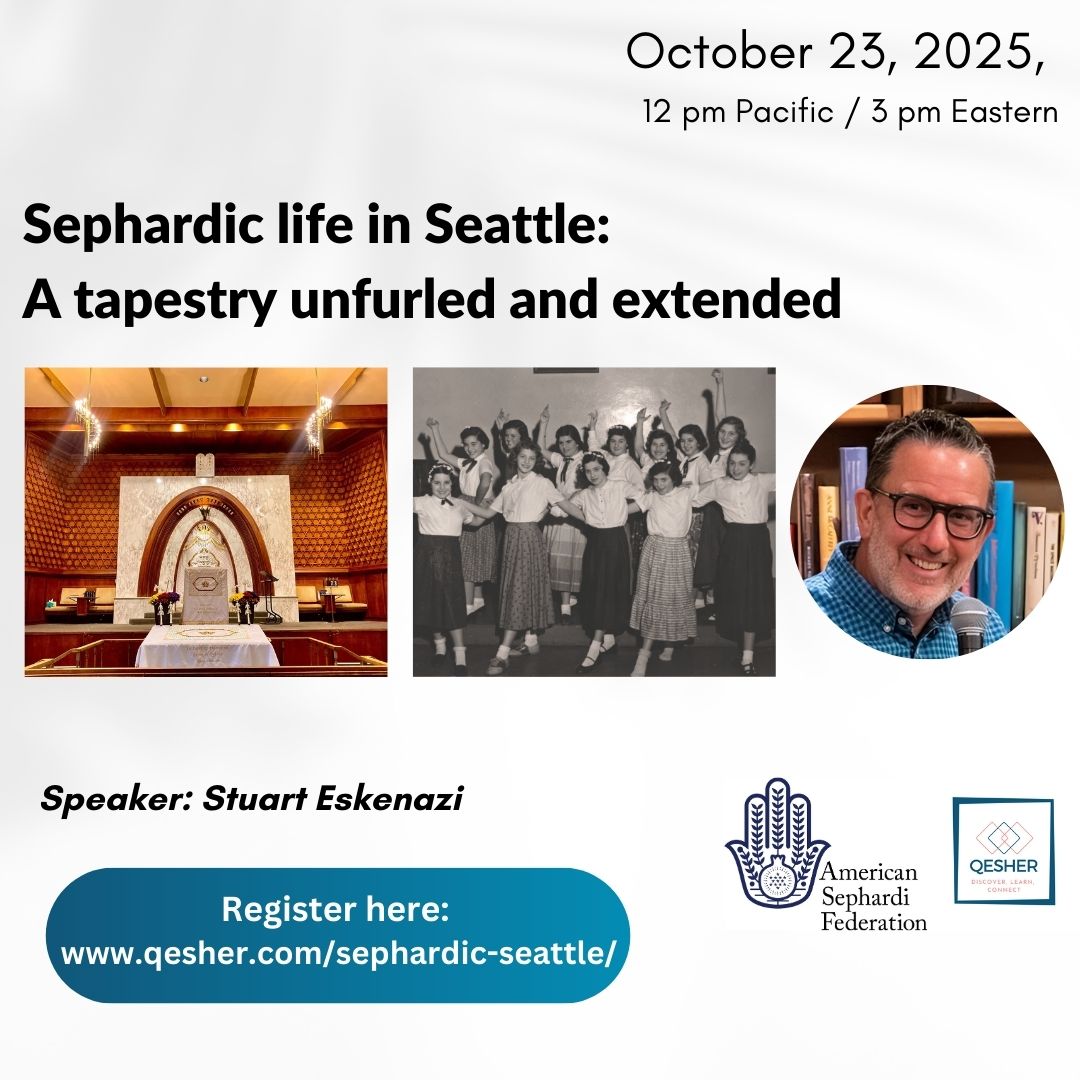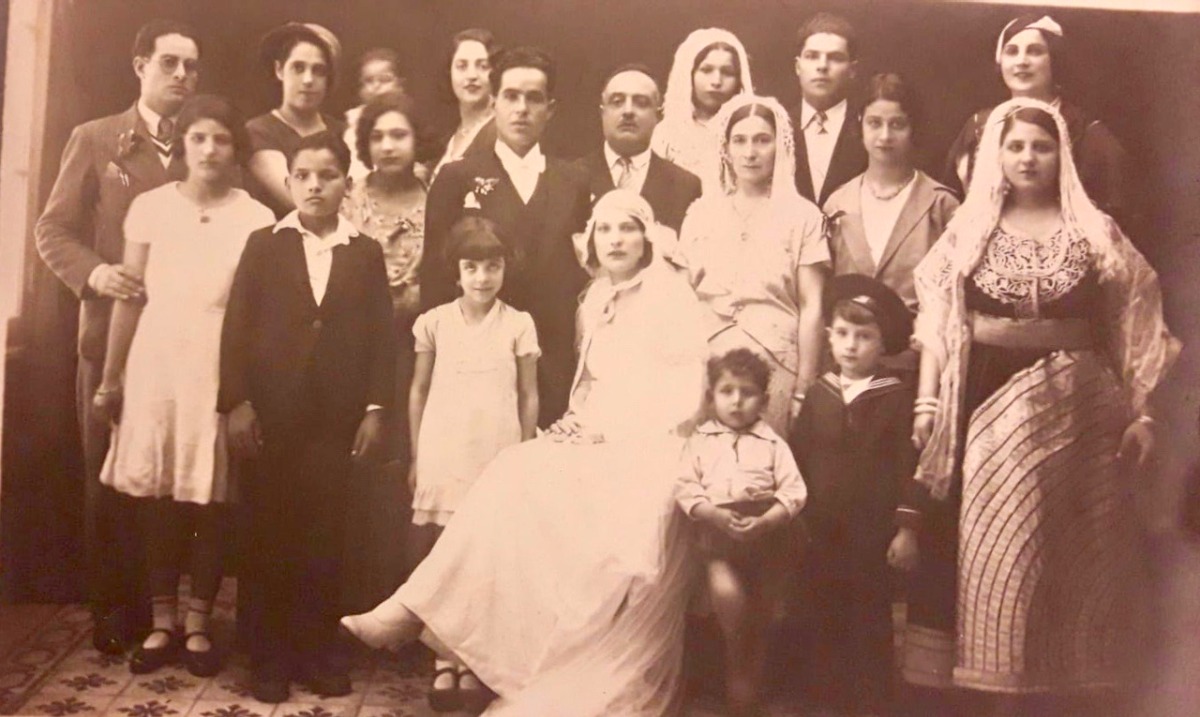“Two years ago, as Israelis celebrated Simchat Torah, one of the most joyous times of the year, Jews around the world awoke to the horrific news out of Israel. This year, in this season of renewal and reflection, we rejoice once more, renewing the joy of the festival with the joy of the return of our hostages and an end to the war...” ~Continue reading the Conference of Presidents of Major American Jewish Organizations’ Statement
Click here to dedicate a future issue in honor or memory of a loved one
Subscribe ◊ Upcoming Events ◊ ASF Sephardi Shop ◊ Donate ◊ Sephardi Ideas Monthly ◊ ASF IJE ◊ ASF Sephardi House ◊ Archive
The Sephardi World Weekly is made possible by Daniel Yifrach, Rachel Sally, Professor Rifka Cook, Maria Gabriela Borrego Medina, Rachel Amar, Deborah Arellano, & ASF VP Gwen Zuares!
Don’t miss “No More Days for Dead Jews,” an October 7th reflection by the ASF’s Executive Director Jason Guberman
“Four Species that Once United a Nation”
By Edward Fram, Institute for Jewish Ideas and Ideals
A Yemenite-Israeli holding the Four Species, Jerusalem, Israel, 2009
(Photo by Eliel Joseph Schafler/Wikipedia)
Edward Fram, Professor in the Department of Jewish History at Ben-Gurion University of the Negev, wonders at the outsized impact of the Mitzvah to take “the four species”—Etrog (citron fruit), Lulav (palm frond from a date palm), Hadas (myrtle branch), Aravah (willow branch)—during the holiday of Sukkot:
It is particularly strange that the four species attained such an important place in ancient Jewish self-consciousness, given their limited place in Jewish life. A fresh look at the character of the commandment may shed some light on why these plants assumed a place in Jewish self-identity that went far beyond the Festival of Sukkot.
Fram begins by explaining that while the Book of Leviticus lists four species for Sukkot, the Jewish tradition teaches that each species stands for a different type of Jew: the etrog symbolizes the person who both studies Torah and fulfills mitzvot, the lulav stands for someone learned but lacking deeds, the hadas represents one who acts righteously but lacks study, and the arava represents those who lack both. Nevertheless
The etrog must be joined with the other species… Every Jew, no matter what his level of Torah knowledge or practice, must see his fellow Jew as forming a unity, each of us belonging to a collective that shares a Divine spark.
Fram, however, offers an additional, thought-provoking historical-geographical perspective on the unifying power of the four species: “‘It may be productive to consider the four species simply for what they are: the flora of four distinct topographical regions of the Land of Israel.’” Each geographic region—arid, streamside, upland, or fertile plain—was, in Fram’s reading, represented by a different species. On Sukkot in ancient Jerusalem, when the whole nation gathered together, “‘four very different regions were represented in this ritual, and each needed the other to perform the precept.’”
While Fram’s interpretation deepens our understanding of the Mitzvah to take the four species, both his interpretation and the traditional interpretation emphasize the same, essential point, “The four species let each group take pride… while giving the group a sense of cohesiveness.” Only together do the four species become a unified mitzvah, turning the Sukkot ritual into a physical act that symbolizes diversity within national unity.
~~~~~~~
FEATURE: Sukkah and Lulav with R’Moshe Habusha
Rabbi Moshe Habusha playing the oud
(Photo courtesy of Emil Salman)
The piyut “Sukkah and Lulav” was composed by Rabbi Moshe ben Yaakov Adahan, a prominent 18th-century Moroccan spiritual leader. In this week’s video, Moshe Habusha, a master of the “Jerusalem Sephardic” cantorial style, sings the piyut with his characteristically controlled pathos and improvisational vocal ornamentation.
Adahan’s “Sukkah and Lulav” praises the fulfillment of the Sukkot commandments and describes how we rejoice before God by gathering the four species (“The four species, each from its place”) and symbolically unifying them ( “All are bound together”). The poem closes with a blessing for Israel and Jerusalem, reinforcing Sukkot’s message of collective celebration.
~~~~~~~
“Experts advise caution about report Christopher Columbus was Jewish”
By Menachem Wecker, JNS
The Christopher Columbus Tomb, Cathedral of Saint Mary of the See, Seville, Andalusia, Spain
(Photo courtesy of Menachem Wecker/JNS)
Was Christopher Columbus a Sephardi Jew from Western Europe? The question has arisen again on account of allegedly newly discovered DNA evidence. Can this new information be fruitfully integrated into our study of Columbus and his life? There are thoughtful arguments pro and con.
Ronnie Perelis, Associate Professor of Sephardic Studies at Yeshiva University’s Bernard Revel Graduate School, calls Columbus’ Sephardi ancestry “‘a story that never dies.’” He explains, “‘For over a century, if not since his own lifetime, people have been obsessed with Columbus’s origins. He is a fascinating, flawed and enigmatic figure.’”
Rather than obsessing over origins, however, Perelis recommends studying Columbus on his own terms:
I encourage people to read his own writings to appreciate his complex identity—he was an autodidact, who took advantage of the explosion of knowledge after the birth of printing to create an eclectic theology that had many Judaic elements—but in a deeply Christian, mystical vein… Genetics doesn’t make someone Jewish.
ASF Executive Director, Jason Guberman, takes a different view. Columbus’ crossing of the Atlantic didn’t take place in a vacuum in 1492, “‘That was also the year the Spanish rulers promulgated the Alhambra Decree, or Edict of Expulsion, completing a process that began in 1391 to destroy the Iberian Peninsula’s Jewish communities by conversion or deportation.’”
Guberman accordingly argues that the new DNA evidence should serve as an impetus for further historical investigation:
There should be renewed scholarly inquiry into Simon Wiesenthal’s thesis that Columbus was on a ‘secret mission’ to find a safe haven for his persecuted people… For example, how the unusual tolerance of Columbus’s family for conversos led to an open Jewish community at Jamaica.
[Note: Hakham Rabbi Dr. José Faur critically examined Columbus’ writings and the historiography about Columbus in 1976. He came to three conclusions:
- Columbus’ “first language was Spanish, and that he did not know Italian sufficiently well to maintain correspondence in that language. This strongly suggests that his family was one of many Jewish families that escaped Spain…. Originally, the family name may have been ‘Colón’ or Colóm,’ a name that he used upon his return to Spain.”
- “Columbus had strong contacts with, and counted the support of conversos and Jews. Many of Columbus’s crew were Jewish,” including: “the interpreter Luis de Torres; Alonso de la Calle,... Rodrigo Sánchez de Segovia… and the ship physician Maestre Bernal.”
- “Columbus seemed to have had special regard for Jewish tradition. The conception, planning, and execution of this project were expressions of his steadfast belief in the preeminence of Jewish knowledge and Jewish scientific thought.”
Of particular note in Faur’s study is his insistence that, contrary to contemporary critics, “Columbus did not regard native Americans to be idolatrous or religiously inferior” and therefore “totally rejected” persecution or even exploitation, preferring pluralism, voluntary conversion to Christianity, and free trade. Once Columbus was removed from power, however,
Spain initiated a racist policy unprecedented in recorded history. People ‘polluted’ (impuros) with even partial non-Christian blood, be it Jewish or Moor, were forbidden to come to the New World. A policy of genocide - the largest both in terms of absolute and relative numbers - towards the natives was carried out with unprecedented sadism. In a short time, the local native population was depleted, and there was need to export slave work from Africa. To preserve Christian ‘purity’ the Inquisition was established throughout the Americas, thus legitimizing the persecution of people on the basis of race. The policies of racism, persecution, violence, plain despotism and authoritarianism, lingering till the present throughout much of Latin America, is the most important legacy first initiated by Columbus’s enemies.
Source: “Columbus: Mystic, Zionist” in The Horizontal Society and Political Thought (The Library of the Jewish People, 2024), 1402-1414.]
~~~~~~~
~~~~~~~
Upcoming Events or Opportunities
Our friends at Qesher in partnership with the American Sephardi Federation present:
Sephardic life in Seattle: A tapestry unfurled and extended
“Home to the third largest Sephardic population in the U.S., Seattle, Washington — tucked pleasantly into the upper-left corner of the country — plays a leading role in preserving the legacy and perpetuating the vitality of Sephardic life across the globe.
With roots planted nearly 125 years ago, Seattle’s Sephardic community continues to revolve around the two congenial but determinedly distinct synagogues founded by immigrants from Turkey and the island of Rhodes. Beyond the synagogues, Seattle’s Sephardic spirit is enjoying a renaissance, led in part by the world-renowned Sephardic Studies Program at the University of Washington, home to one of the largest online repositories of Ladino books and Sephardic artifacts in the world. The city also has been at the center of the movement to establish citizenship for Sephardic Jews in Spain and the revival of the Ladino language. Seattle also is the administrative home for the only youth summer camp in the U.S. immersed in Sephardic traditions and values.”
Thursday, 23 October, at 3:00 PM ET
Sign-up Now!
Tickets: $18
About the speaker:
“Stuart Eskenazi was born into a proud (and loud) Sephardic family in Seattle. He worked more than 25 years as a newspaper reporter in Washington state and Texas, and now offers writing, editing and communications consulting services to organizations seeking to do good in the world. Over the past 10 years, he has uplifted stories of local Jewish communities on behalf of the Washington State Jewish Historical Society and Seattle Sephardic Network. In 2017, he wrote and curated an exhibit about Seattle’s Sephardic life, Shalom! Sefarad, that was presented in several cities across Spain. In 2023, he wrote an update to the book Family of Strangers, the definitive history of Jewish life in Washington state. He currently leads walking tours of Seattle's old Sephardic neighborhood. After obtaining Spanish citizenship in 2023, he splits his time between Seattle and San Sebastián, Spain.”
~~~~~~~
Our friends at the Center for Jewish History in partnership with the American Sephardi Federation present:
Family History Today: A Moroccan Jewish Genealogical Journey
“Join us for a fascinating talk with Raquel Levy-Toledano as she shares her remarkable journey to uncover the origins of her great-grandfather, born in Manchester. What began as a family mystery evolved into an international quest spanning Morocco, England, Portugal, the Azores, and Cape Verde, combining traditional archival research with genetic testing to reveal an unknown branch of her family—the Levy Belfsahi.
Along the way, Raquel connected with distant relatives around the world and shed light on the urgent need for more organized research on Moroccan Jewish genealogy. To help bridge this gap, she founded the Jewish Moroccan Genealogy group on Facebook, which now links over 400,000 profiles of Moroccan and Algerian Jews, reconnecting families and reconstructing a shared history.”
Monday, 3 November, at 5:00 PM ET
Sign-up Now!
Live on Zoom
Tickets: Pay what you wish - Free
About the speaker:
“Raquel Levy-Toledano was born in Morocco, then moved to France where she received her MD in gynecology and PhD in molecular endocrinology, followed by postdoctoral training at the NIH in Maryland. She is a board member of IAJGS, a board member of the Cercle de Généalogie Juive where she manages the Genetic Genealogy Group, a member of the General Assembly of the International Institute for Jewish Genealogy in Israel, president of NAJMA (Nos Ancêstres Juifs Marocains et Algériens) Genealogical Society, an expert curator of Geni’s Moroccan and Algerian Jewish family tree, co-administrator of the Avotaynu DNA project section involving North African Jews and founder of the Généalogie des Juifs Marocains Facebook Group, which has 13,000 members. She has published several articles in Généalo-J and other journals and has presented at numerous conferences and Zoom meetings.”

